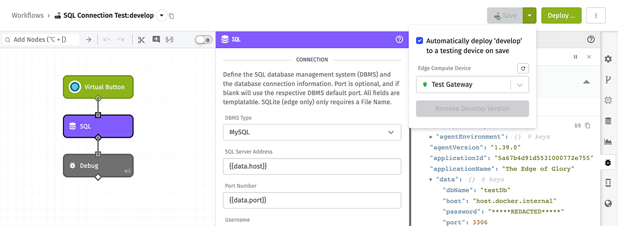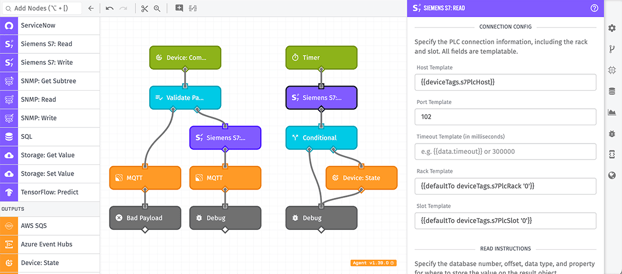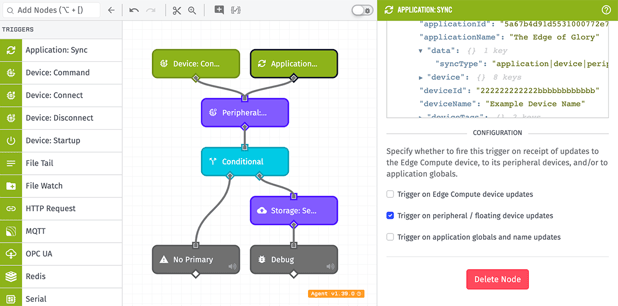Today’s platform update focuses heavily on Losant’s suite of Edge Compute functionality, bringing improvements to the workflow development process and several new nodes.
Improved Edge Workflow Development
The Losant Product and Education teams regularly touch base with our users, and we’ve discovered that their Edge Workflow development process is similar to ours: They build, deploy, and modify workflows for a single device sitting on a table next to them until they are happy with the results, and then deploy those changes to the rest of their fleet.
To that end, we’ve removed some steps from the edge workflow editing and testing process by allowing for the automatic deployment of a workflow’s ‘develop’ version to a single device during development.

From the workflow editor, users can choose one device from their application to act as a testing unit, and assuming that device is connected to our MQTT broker and running GEA version 1.39.0 or higher, every save of the ‘develop’ version will immediately deploy to the chosen device. It is no longer necessary to create a new version and configure a new deployment for every modification you wish to test.
Once you are satisfied with the changes, you can create a version of the workflow and deploy the updates to your entire fleet - including putting the test device back into production use if desired. You may still view and interact with deployed versions on any Edge Compute device in your application.
This is the biggest improvement to edge workflow development since we introduced the live look modal a couple years ago. Today’s changes are already a big hit with our internal team as they cut even more overhead out of the process. This update also sets us up for some more edge workflow enhancements in the near future. Expect to hear more in the coming months.
Siemens S7 Protocol Support
Today’s release adds a new communication option to our roster of supported edge protocols through the new Siemens S7: Read and Siemens S7: Write Nodes.

Siemens manufactures a wide range of PLCs that are used in industrial automation, motors and generators, and buildings and infrastructure, all of which have applicable use cases in the Internet of Things. You can find their hardware in most factories, laboratories, and commercial real estate.
With these new nodes, users can input a connection configuration and a set of read or write instructions for communicating with a Siemens PLC on the same network as the Edge Compute device, allowing for tracking and controlling their hardware remotely or programmatically through the Gateway Edge Agent.
Several Losant users have requested the S7 protocol as an Edge Compute integration, and we are happy to deliver first-class support for communicating with Siemens hardware as part of this release.
Other Updates
As always, this release comes with a number of smaller feature improvements, including:

- We’ve introduced a new Application: Sync Trigger for Edge Workflows, which can execute a flow on receipt of updates to the Edge Compute device, its peripherals, and/or application globals. Use cases that required polling the Peripheral: Get Node with a Timer Trigger can be simplified through the use of this new trigger.
- We’ve exposed the AWS SQS, Azure Event Hubs, GCP Pub/Sub, and Particle Call Nodes in Edge Workflows, which allows for publishing to these services directly from your Edge Compute devices without having to go through an Application Workflow first.
- In Application and Experience Workflows, users can now publish to those same cloud queue services without having to set up a Losant integration first. This enables publishing messages to your own cloud infrastructure without also consuming messages (and payloads) from that same service.
- The “Resolution” field in the Data: Time Series Node now accepts custom values outside of the suggested resolutions for a given duration. More importantly, this field now accepts string templates, allowing the resolution to be defined by a value on the workflow payload. We have similar improvements for this node and the Data: Gauge Query Node coming in the next couple of product updates.
What’s Next?
With every new release, we listen to your feedback. By combining your suggestions with our roadmap, we can continue to improve the platform while maintaining its ease of use. Let us know what you think in the Losant Forums.
